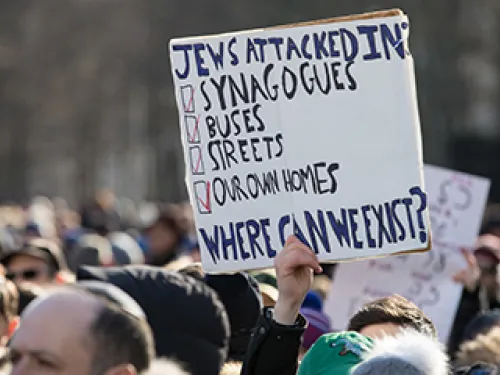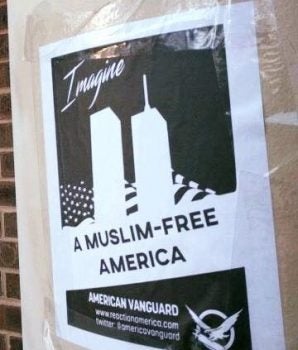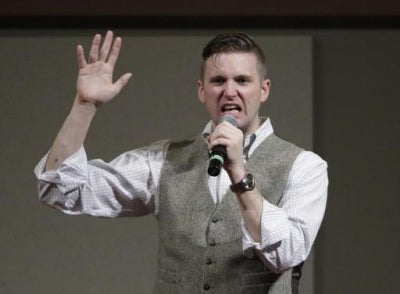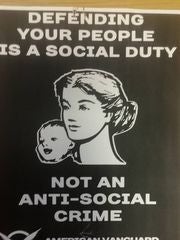Related Content

March 06, 2017
Updated: June 09, 2017
White supremacists are engaged in unprecedented outreach efforts on American college campuses – another sign that these hate groups feel emboldened by the current political climate.
Throughout the 2016-17 school year, students, faculty and staff on 110 American college campuses were confronted by 159 incidents of racist fliers and stickers, as well as numerous on-campus appearances by white supremacists and several rounds of anti-Semitic, racist faxes and emails.
White supremacists are mobilizing in hopes of translating their online activism to “real world” action, and campuses – and young people – are prime targets, in part because they are still figuring out who they are, and what they believe. Extremists also undoubtedly see value in recruiting a new generation that can carry the movement for years to come.
Longtime white supremacist Jared Taylor recently wrote on his website, American Renaissance, that colleges are of special interest “because they are bastions of anti-white propaganda.” Before he imploded publicly in February, Islamaphobic and misogynist gadfly Milo Yiannopoulos told CNN, “I am speaking on college campuses because education … is really what matters. It’s a crucible where these bad ideas are formed. Bad ideas like … progressive social justice, feminists, Black Lives Matter…”
Yiannopoulos’ appearances (some of which were cancelled) seem to have had an energizing impact on other racists. Nathan Damigo, founder of the white supremacist group Identity Ervopa, has called Yiannopoulos “an inspiration,” and showed up at the (ultimately cancelled) Yiannopoulos speech at UC Davis, hoping to poach a few fans for his own cause, which he outlined in a Tweet: “We will not rest until Alt-Right ideas are represented on campuses nationwide.”
What’s happening?
Over the course of the 2016-17 academic year, there were 159 white supremacist fliering incidents on 110 American college campuses. The incidents occurred in 34 states, plus the District of Columbia, with a disproportionate number in Texas and California.
While the vast majority of white supremacist campus actions involve hateful fliers (“Imagine a Muslim-Free America,”) and stickers (“Make America White Again”), white supremacists have also sent anti-Semitic faxes and, in the case of Richard Spencer, delivered speeches on campus.
Many of these incidents are linked to larger coordinated promotional efforts by white supremacist groups, like Identity Evropa’s “Project Siege,” which includes actual campus recruitment visits, and American Vanguard’s “Northern Propaganda Campaign.” Not coincidentally, these two groups are responsible for the majority of the white supremacist fliers and events tracked over the last several months.
In January, American Renaissance launched a hate-filled campus campaign, which for now seems to be limited to hanging “pro-white” propaganda posters. “Racial activists,” Jared Taylor wrote on the American Renaissance website, should place the “attractive posters” in “high-traffic areas” around campus.
Racist fliers and posters have adorned parking garages, street signs, billboards, utility poles and along corridors.
Andrew Auernheimer, a white supremacist hacker known as “Weev,” took targeting to the next technological level when he sent out anti-Semitic and racist fliers via many thousands of campus printers across the country. One flier, which was adorned with swastikas, read in part: “I unequivocally support the killing of children. I believe that our enemies need such a level of atrocity inflicted upon them…So the hordes of our enemies from the blacks to the Jews to the federal agents are deserving of fates of violence so extreme that there is no limit to the acts by which can be done upon them in defense of the white race.” The fliers referenced The Daily Stormer, Andrew Anglin’s neo-Nazi website.
“Real life” activity
Until recently, on-the-ground white supremacist actions have been relatively infrequent on college campuses – but there have been notable exceptions. In 2013, Matthew Heimbach attempted to start a White Student Union at Towson University in Maryland to “represent the unique cultural heritage, folk customs and strong Christian traditions that define white civilization.” Later that same year, Patrick Sharp established a similar group at Georgia State University.
In 2015, two white supremacist groups, the now-defunct National Youth Front (NYF) and Traditionalist Youth Network (TYN), launched a campaign against two intellectuals whose work focuses on race-related issues. The targets of their online and on-campus protests were Lee Bebout, an associate professor of English at Arizona State University who was teaching a course called “U.S. Race Theory and the Problem of Whiteness,” and Tim Wise, an independent scholar who delivers lectures on racism on campuses across the country.
These days, white supremacists are taking more forceful steps to establish a physical presence on campus. Identity Evropa (founded by Nathan Damigo) was clear in its goals – and used fittingly “academic” language – when describing “Project Siege” plans for the 2016-17 school year: Go talk to actual students. “Project Siege is the beginning of a long-term cultural war of attrition against the academia’s cultural Marxist narrative that is maintained and propagated into society though the indoctrination of the future managerial class. If we are to be successful in combating the current paradigm,” the online message read, “it is imperative that we create space for our ideas at universities across the country. Speaking with students and helping them unpack some of their assumptions while gaining name recognition for our organizations are the ways in which we will create the foundation for that space.”
Sometimes, students take things into their own hands. Damigo, for example, is a student at California State University at Stanislaus.) At the University of Wisconsin, Daniel Dropik, a 33-year-old student-employee who was convicted in 2006 of setting fire to two black churches, attempted to form the Madison branch of the American Freedom Party, which urges students to “fight anti-white racism.” The American Freedom Party is a white supremacist group founded by William Johnson, and was heavily involved in the 2016 presidential campaign, calling voters nationwide urging them to vote for Trump.
White supremacist events on campus face particular scrutiny and, in some cases, speakers are able to circumvent the school altogether, avoiding heated debates over free speech rights versus hate speech laws. In December, when Richard Spencer spoke on the Texas A&M campus, he wasn’t there as a guest of the University. Instead, he spoke to supporters and onlookers in a room rented for the occasion by local neo-Nazi Preston Wiginton.
On March 2, 2017, students reported that Wiginton was on the Texas A&M campus passing out flyers and recruiting for the Alt Right.
Why now?
White supremacists, emboldened by the rhetoric of the 2016 presidential campaign, are stepping out of the shadows and into the mainstream.
In January, Jared Taylor wrote, “It is widely understood that the election of Donald Trump is a sign of rising white consciousness….Now is the time to press our advantage in every way possible.”
Richard Spencer has stated that now is the time to “professionalize” white supremacist beliefs, and is currently fundraising to take his message to campuses across the country. “These types of events are tremendous opportunities for us to communicate our message,” he told supporters in December. “They are ways for us to reach millions of people who would otherwise never have heard our ideas.”
Campus responses
Fear and anger are the most common reactions to
A “pro-white” American Vanguard poster found at Purdue University
white supremacist fliers and events, usually followed by a powerful response from students and others who are appalled by the display of hate and divisiveness. Rallies and other gatherings are common. At Purdue, a group of students replaced American Vanguard’s “pro-white” posters with their own inclusive messages, and loud protests met Richard Spencer when he arrived to speak at Texas A&M.
College administrators are responding more quickly and forcefully to campus hate speech; the president of the University of Texas called for a town hall meeting after anti-Muslim and anti-immigrant fliers (courtesy of American Vanguard) were found all over the Austin campus. The University of Michigan recently launched its Diversity, Equity and Inclusion initiative, which the school hopes will make all campus populations feel safer and more empowered.















